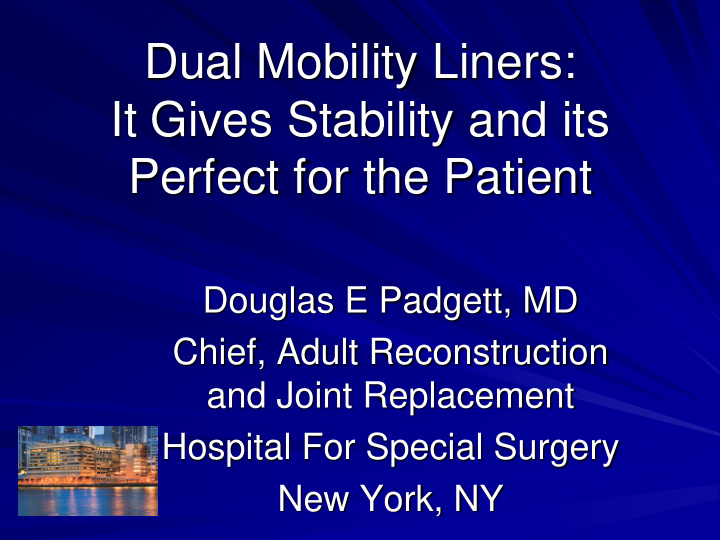



Dual Mobility Liners: It Gives Stability and its Perfect for the Patient Douglas E Padgett, MD Chief, Adult Reconstruction and Joint Replacement Hospital For Special Surgery New York, NY
Disclosures Consultant – DJO Global – PixarBio Board Membership: – Hip Society – AJRR – BOS – Journal of Arthroplasty
Fact: Dislocation after THR Remains a problem for both surgeon and patient
Fact: Instability after THR: Magnitude of the Problems “Epidemiology of Revision THR” – 22.5% of revision THR performed for instability Bozic et al, J Bone Joint Surg, 2009
Fact: Strategies to decrease Incidence of Instability – Soft tissue repair – Improvement of Head-neck ratio – Larger head diameter
Fact: Impact of Change: Reduction: down but not 0 !!
Meanwhile, over in Europe: Use of Dual Mobility Sockets Excellent track record in France – Designers – Non-designers
Confession: Personal Reluctance to Use Concerns: – Wear – Impingement – Modular version Issues at the metal shell – liner interface – 2 patients had MRI findings suspicious for ALTR J Arthroplasty 2016
Improvement in Implant Delivery: The Safe Zone “We seek the grail !”
Two Problems with the “safe zone”
Problem #1 with the safe zone: Can You Hit it ?
MGH Data: 2000 THR’s 50% on target
What About Enabling Technology ?
Acetabular Cup Position: Lewinnek Zone Plot (n=119) 45 40 35 30 Cup Version (Degrees) 25 20 15 10 5 0 0 20 40 60 Cup Inclination (Degrees) * 10-30 version / 30-50 abduction
Haptic THR: Initial Consectutive Experience Used in selected patients with a tendency to use in – dysplasia – Hypermobile – Prior spine surgery – Despite this, dislocation still occurs!
Problem #2 Where is the safe zone ? (Is there really a safe zone ?)
HSS Registry Data a tale of 7000 THR’s 2.1 % dislocation rate Dislocation rate the same in the “safe zone” and out of the “safe zone” Esposito et al J Arthroplasty, Jan ‘15
Why is this so ?
Spino-pelvic Alignment (thanks to Larry Dorr, MD)
So a 1-2% dislocation rate isn’t bad ! Why push it ? A 1% risk of a complication is 100% if you’re the one with the problem ! Impact of bundled care ! – “You break it, you own it!”
Dual Mobility: Revisited Stability – Does it work ? Wear – Will it fail prematurely ? Corrosion – Interface
Dual Mobility and ROM; Computational Analysis Extremely favorable head-neck ratio Greatest benefit observed in stablilty was internal rotation at 90 of internal rotation – (risk position for Klingenstein et al JOA, 2013 posterior dislocation)
Dual Mobility Cup Designers initial report 16 year followup: – 437 hip – Non-selected (all comers) – 5 dislocations (1.1%) – No described lysis ! – Vielpeau et al International Ortho 2011
Results of Dual Mobility Cups (high risk groups) Caton et al: – .9% dislocation rate at 10 yrs with Charnley Benson et al: – Used DMC for fx cohort: 2% dislocation Epinette et al: – Patients < 70 yrs – 0% dislocation at 4 yrs f/u Increasing use in revision THR !
2017 Otto Aufranc Award DM vs Large Diameter Heads 302 revision THRs – 126 DM (47mm OD) – 176 40 mm head Dislocation rates: – DM 3% – LDH 10% Re-revision / Reoper – DM 1% 6% Abdel et al, AAOS ‘17 – LDH 6% 15%
Wear in Dual Mobility Simulator Clinical Studies
Hip Simulator Impingement Setup Impingement occurs at 50° Rotate cup additional 27° Interference of neck and chamfer from 0.02- 0.05 inches Despite impingement, minimal damage / wear reported
DM Clinical Performance ex vivo 33 retrieved DM liners – 29 ADM, 4 MDM – LOI mean 15 mos Range 0-96 months – Slight loss of machining marks outer bearing, more on inner – Deviation mapping: Greater deviation inner than outer beargin – Suggests most D’Apuzzo et al, J Arthroplasty ‘16 motion is at inner bearing
Corrosion at Modular DM Interface Limited data Ion level in well functioning THR’s – No difference btw CoC, MoP, DM HSS Retrieval lab: – Light micro and selected SEM – No evidence of corrosion
Conclusion: DM Effective Low risk of wear Even the modular version: – Safe !
Summary Etiology of instability remains enigmatic ! Despite the improvements in: – Mechanics – Position – Delivery
The Scariest Patient in America! What do we do for this patient ?
The Second Scariest Patient The 58 yo Hedge Fund Billionaire
The Solution:
Thank You
Recommend
More recommend